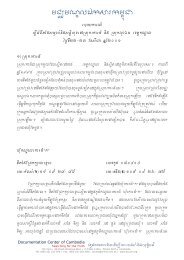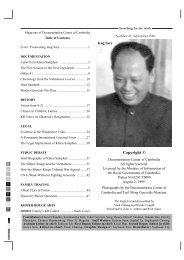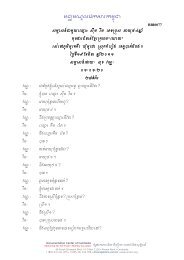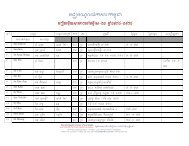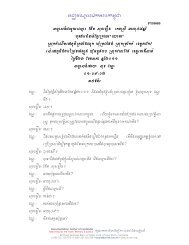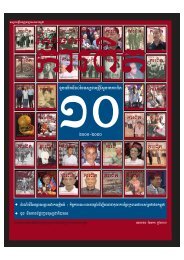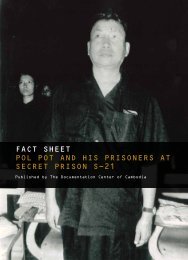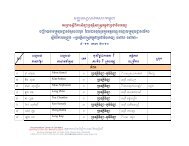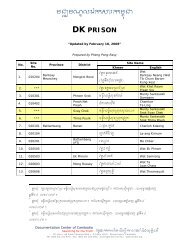Searching for the truth Issues 28 - Documentation Center of Cambodia
Searching for the truth Issues 28 - Documentation Center of Cambodia
Searching for the truth Issues 28 - Documentation Center of Cambodia
Create successful ePaper yourself
Turn your PDF publications into a flip-book with our unique Google optimized e-Paper software.
<strong>Searching</strong> <strong>for</strong> <strong>the</strong> Truth ⎯ PUBLIC DEBATE<br />
<strong>the</strong> followers perceive <strong>the</strong> leader as charismatic.<br />
Ano<strong>the</strong>r <strong>the</strong>ory states that individuals who have<br />
solved <strong>for</strong> <strong>the</strong>mselves problems <strong>the</strong> followers have not<br />
been able to solve <strong>for</strong> <strong>the</strong>mselves are perceived as<br />
charismatic. The perception <strong>of</strong> charisma is <strong>of</strong> great<br />
importance only between <strong>the</strong> leaders and <strong>the</strong>ir<br />
followers. How non-followers perceive <strong>the</strong> leaders has<br />
very little relevance to <strong>the</strong> notion <strong>of</strong> charisma.<br />
According to Weber, people have extraordinary needs,<br />
especially in times <strong>of</strong> great stress and crisis in a<br />
society, and leaders who are able to satisfy <strong>the</strong>se needs<br />
are considered charismatic. Charismatic leaders help<br />
<strong>the</strong>ir followers achieve a state <strong>of</strong> transcendence by<br />
becoming <strong>the</strong> embodiment <strong>of</strong> <strong>the</strong> qualities <strong>the</strong>y wish<br />
that <strong>the</strong>y possessed. Charismatic leaders appear most<br />
frequently in times <strong>of</strong> societal crisis.<br />
What are some <strong>of</strong> <strong>the</strong> common qualities and<br />
characteristics <strong>of</strong> charismatic leaders? Charismatic<br />
leaders are able to distill complex thoughts and ideas<br />
into simple messages through <strong>the</strong> use <strong>of</strong> symbolism,<br />
analogies, and metaphors. Charismatic leaders embrace<br />
risk and feel empty in its absence. And, <strong>the</strong>y take<br />
chances without fear <strong>of</strong> failure. Charismatic leaders<br />
rebel against <strong>the</strong> status quo and conventional wisdom.<br />
According to Weber, charismatic leaders reject rational,<br />
economic objectives and orders, choosing more<br />
“irrational” but more humanistic pursuits, and that one<br />
<strong>of</strong> <strong>the</strong> signs <strong>of</strong> charismatic leadership lies in <strong>the</strong> leader’s<br />
ability to leave a significant mark on <strong>the</strong> traditional<br />
institutionalized structure that he rejects. Charismatic<br />
leaders have robust empathic capacity⎯<strong>the</strong>y attempt<br />
to see <strong>the</strong> world through <strong>the</strong>ir followers’ eyes. Finally,<br />
charismatic leaders challenge, prod and poke <strong>the</strong>ir<br />
followers to test <strong>the</strong>ir courage and <strong>the</strong>ir commitment.<br />
Charismatic leaders score high on expression <strong>of</strong> values,<br />
emphasis on commitment, setting high standards, stressing<br />
a sense <strong>of</strong> mission, talking optimistically about <strong>the</strong><br />
future, expressing confidence when making personal<br />
sacrifices, providing encouragement to followers, and<br />
displaying conviction in ideals.<br />
<strong>Documentation</strong> <strong>Center</strong> <strong>of</strong> <strong>Cambodia</strong> (DC-Cam)<br />
Number <strong>28</strong>, April 2002<br />
Pol Pot’s Rise to Leadership<br />
Post-colonial <strong>Cambodia</strong> was a society with a<br />
deeply rooted sense <strong>of</strong> hierarchy that permitted one<br />
man to exercise enormous power. From 1945 until<br />
1970, that one man was Norodom Sihanouk, who<br />
ruled <strong>Cambodia</strong> first as king and <strong>the</strong>n as its Head <strong>of</strong><br />
State (Chandler, 1991, pp. 14-178). <strong>Cambodia</strong>n<br />
political structure during Sihanouk’s rule bestowed<br />
“power on a small group <strong>of</strong> men who exploit[ed] <strong>the</strong><br />
majority <strong>of</strong> <strong>the</strong> people at every level” (Chandler, 1999,<br />
p. 39). “Nepotism and corruption” (Chandler, 1999, p.<br />
47) were <strong>the</strong> way <strong>of</strong> life. <strong>Cambodia</strong> was an agrarian<br />
society whose economy did not develop beyond<br />
agriculture and o<strong>the</strong>r small labor-intensive industries.<br />
The absence <strong>of</strong> strong economic bases manifested in<br />
<strong>the</strong> people’s low standard <strong>of</strong> living. The resulting gulf<br />
<strong>of</strong> economic disparities between a concentrated group<br />
<strong>of</strong> wealthy ruling elite and <strong>the</strong> poor masses served as<br />
<strong>the</strong> battle cries <strong>for</strong> social and political changes intended<br />
to wrest political and economic power from <strong>the</strong> ruling<br />
elite and to distribute <strong>the</strong>m to <strong>the</strong> poor masses.<br />
Pol Pot’s entrance onto <strong>Cambodia</strong>’s political<br />
landscape was inspired by <strong>the</strong> desire to bring about<br />
such social and political changes to benefit <strong>the</strong> poor<br />
masses. After having spent three years at a university<br />
in France, where he was exposed to Communist ideology,<br />
Pol Pot returned to <strong>Cambodia</strong> in 1953. Pol Pot “saw<br />
communism as a set <strong>of</strong> techniques” that would allow<br />
<strong>for</strong> social and political changes to occur in <strong>Cambodia</strong><br />
(Chandler, 1999, p. 34).<br />
To spread <strong>the</strong> message <strong>of</strong> Communism to his<br />
compatriots, in 1956 Pol Pot embarked on a career<br />
teaching French and geography at a private college in<br />
Phnom Penh, <strong>the</strong> capital <strong>of</strong> <strong>Cambodia</strong>. Teaching<br />
provided Pol Pot with a stage <strong>for</strong> his budding political<br />
talents to attract young people to <strong>the</strong> Communist<br />
movement. Many recollections <strong>of</strong> Pol Pot referred to<br />
his skills as a teacher. In choosing to play this role, he<br />
drew on <strong>the</strong> reservoir <strong>of</strong> reverence <strong>Cambodia</strong>ns have<br />
always had <strong>for</strong> <strong>the</strong>ir teachers, reflecting <strong>the</strong> centuries<br />
37<br />
100 100 100 100 100 100 50 50 50 50<br />
Black<br />
Yellow<br />
Magenta<br />
Cyan




